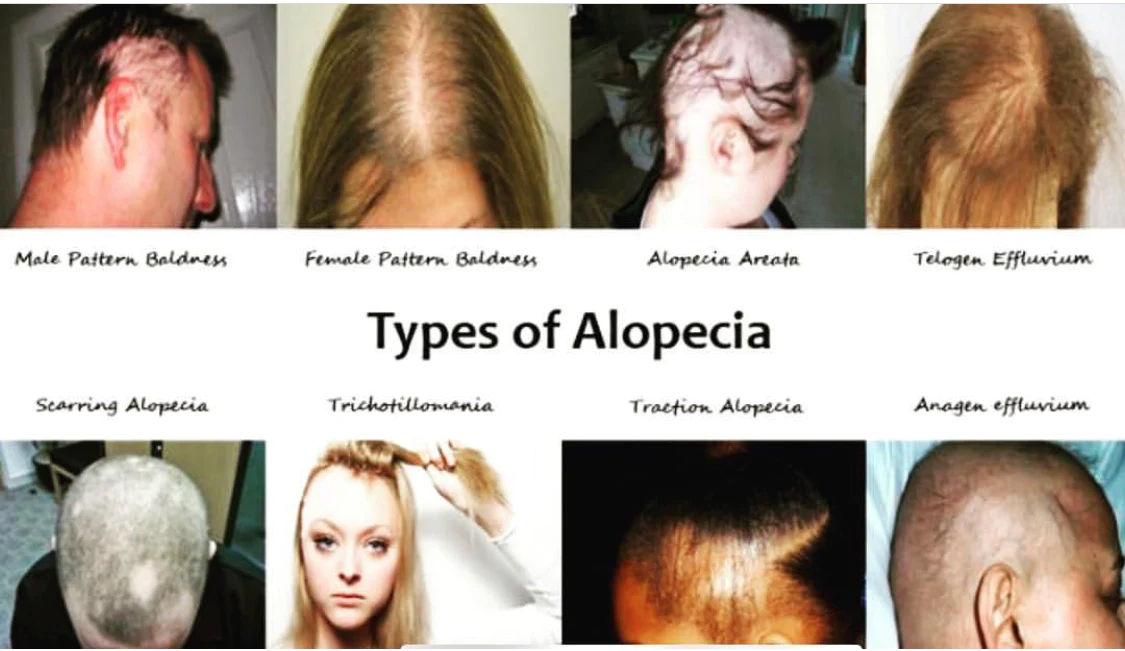
Alopecia is partial or complete loss of hair from areas of the body where it normally grows. It is characterized by a variety of patterns and causes. Alopecia can affect the scalp, eyebrows, eyelashes, beard and body. Here’s a detailed description of alopecia from a dermatologist’s perspective:
Types of Alopecia:
- Androgenetic Alopecia (Male and Female Pattern Baldness): This is the most common type of hair loss, affecting both men and women. It is primarily genetic and hormonal in nature. In men, it often leads to a receding hairline and balding on the crown. In women, it typically results in diffuse thinning of the hair.
- Alopecia Areata: Alopecia areata is an autoimmune disorder in which the immune system attacks hair follicles. It can result in small, round patches of hair loss on the scalp or other areas of the body. In some cases, it can progress to total hair loss (alopecia totalis) or loss of all body hair (alopecia universalis).
- Telogen Effluvium: This type of hair loss is typically caused by a significant physiological or emotional stressor. Temporary hair shedding due to factors like stress, illness, medication, or childbirth. It leads to a temporary thinning of the hair as more hair follicles enter the resting (telogen) phase of the hair growth cycle.
- Traction Alopecia: Traction alopecia occurs due to repetitive pulling or tension on the hair follicles, often caused by tight hairstyles such as braids, cornrows, or ponytails. It is common among individuals who consistently wear hairstyles that put strain on their hair.
- Cicatricial Alopecia: Cicatricial alopecia refers to hair loss accompanied by scarring of the scalp. It can result from various inflammatory skin conditions, infections, or other disorders that damage hair follicles.
- Frontal Fibrosing Alopecia: Frontal fibrosing alopecia is a type of scarring alopecia that typically affects postmenopausal women. It causes hair loss at the front of the scalp and may also affect the eyebrows.
- Other uncommon types are Anagen Effluvium, Trichotillomania, Loose Anagen Syndrome, Secondary Syphilis.
Causes:
These may include genetic predisposition, hormonal imbalances, autoimmune responses, underlying medical conditions, medications, nutritional deficiencies, and lifestyle choices.
Treatment:
The choice of treatment for alopecia depends on its type, severity, and underlying causes. Dermatologists may recommend various interventions, including:
- Multivitamins and minerals to overcome nutritional deficiencies
- Oral medications (e.g., finasteride) to address hormonal factors.
- Topical medications (e.g., minoxidil) to promote hair regrowth.
- Platelet-rich plasma (PRP) therapy to stimulate hair follicles.
- Steroid injections for alopecia areata.
- Hair transplant surgery for advanced cases.
- Treating underlying medical conditions contributing to hair loss.
- Lifestyle modifications and counseling
In summary, dermatologists approach alopecia with a comprehensive understanding of its types, causes, and treatment options. Their goal is to diagnose the specific type of alopecia, identify its underlying causes, and provide personalized treatment plans to help patients achieve optimal hair regrowth and manage their condition effectively.

